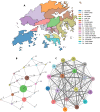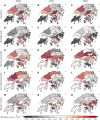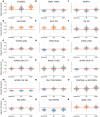The sociospatial factors of death: Analyzing effects of geospatially-distributed variables in a Bayesian mortality model for Hong Kong
- PMID: 33760852
- PMCID: PMC7990297
- DOI: 10.1371/journal.pone.0247795
The sociospatial factors of death: Analyzing effects of geospatially-distributed variables in a Bayesian mortality model for Hong Kong
Abstract
Human mortality is in part a function of multiple socioeconomic factors that differ both spatially and temporally. Adjusting for other covariates, the human lifespan is positively associated with household wealth. However, the extent to which mortality in a geographical region is a function of socioeconomic factors in both that region and its neighbors is unclear. There is also little information on the temporal components of this relationship. Using the districts of Hong Kong over multiple census years as a case study, we demonstrate that there are differences in how wealth indicator variables are associated with longevity in (a) areas that are affluent but neighbored by socially deprived districts versus (b) wealthy areas surrounded by similarly wealthy districts. We also show that the inclusion of spatially-distributed variables reduces uncertainty in mortality rate predictions in each census year when compared with a baseline model. Our results suggest that geographic mortality models should incorporate nonlocal information (e.g., spatial neighbors) to lower the variance of their mortality estimates, and point to a more in-depth analysis of sociospatial spillover effects on mortality rates.
Conflict of interest statement
The authors have read the journal’s policy and have the following competing interests: DRD was a paid employee of Massachusetts Mutual Life Insurance at the time of the study. DRD is currently affiliated with Charles River Analytics Inc. There are no patents, products in development or marketed products associated with this research to declare. This does not alter our adherence to PLOS ONE policies on sharing data and materials.
Figures






Similar articles
-
"Geography of suicide in Hong Kong: spatial patterning, and socioeconomic correlates and inequalities".Soc Sci Med. 2015 Apr;130:190-203. doi: 10.1016/j.socscimed.2015.02.019. Epub 2015 Feb 17. Soc Sci Med. 2015. PMID: 25706063
-
Part 4. Interaction between air pollution and respiratory viruses: time-series study of daily mortality and hospital admissions in Hong Kong.Res Rep Health Eff Inst. 2010 Nov;(154):283-362. Res Rep Health Eff Inst. 2010. PMID: 21446214
-
Impact of the 1990 Hong Kong legislation for restriction on sulfur content in fuel.Res Rep Health Eff Inst. 2012 Aug;(170):5-91. Res Rep Health Eff Inst. 2012. PMID: 23316618
-
Socioeconomic correlates of infant mortality in Hong Kong, 1979-93.Scand J Soc Med. 1998 Dec;26(4):281-8. doi: 10.1177/14034948980260040901. Scand J Soc Med. 1998. PMID: 9868753
-
Geographical and socio-economic variations in ischaemic heart disease in men in Hong Kong.Ann Acad Med Singap. 1984 Apr;13(2):211-5. Ann Acad Med Singap. 1984. PMID: 6497318
References
Publication types
MeSH terms
LinkOut - more resources
Full Text Sources
Other Literature Sources

